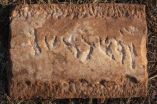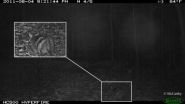(Press-News.org)
VIDEO:
Depicting each copy of COPI as a triangle, the different arrangements of these building blocks become easier to spot.
Click here for more information.
These spheres may look almost identical, but subtle differences between them revealed a molecular version of the robots from Transformers. Each sphere is a vesicle, a pod that cells use to transport materials between different compartments. The images, produced by Marco Faini from John Briggs' lab at the European Molecular Biology Laboratory (EMBL), in Heidelberg, Germany, are the first high-resolution view of the three-dimensional structure of such a pod. They show a particular type of vesicle that is encased by a protein called COPI, and whose structure had never been seen before.
VIDEO:
A COPI protein (yellow, green, blue) on the vesicle’s membrane (red) can change shape to connect to more or fewer copies of itself, making vesicles of different sizes and shapes....
Click here for more information.
Several copies of the COPI protein attach to each other to form a coat around the vesicle's membrane. Briggs and colleagues were surprised to find that the COPI building blocks are capable of a 'transformer' act: they can change shape to connect to more or fewer copies of themselves. So by changing the shape of individual COPI blocks, the cell could create vesicles of different shapes and sizes, for instance to transport different kinds of cargo.
Previously, scientists had been able to create and determine the structure of 'cages' formed by parts of the protein coats that encase other types of vesicles, but this study, published online today in Science, was the first to obtain high-resolution images of complete vesicles, budded from a membrane.
INFORMATION:
The work was carried out in collaboration with the lab of Felix Wieland at Heidelberg University in Germany.
Picture release: More than meets the eye
'Transformer' protein makes different sized transport pods
2012-05-28
ELSE PRESS RELEASES FROM THIS DATE:
Oldest Jewish archaeological evidence on the Iberian Peninsula
2012-05-28
On a marble plate, measuring 40 by 60 centimetres, the name "Yehiel" can be read, followed by further letters which have not yet been deciphered. The Jena Archaeologists believe that the new discovery might be a tomb slab. Antlers, which were found very close to the tomb slab in the rubble gave a clue to the age determination. "The organic material of the antlers could be dated by radiocarbon analysis with certainty to about 390 AD," excavation leader Dr. Dennis Graen of the Jena University explains. "Therefore we have a so-called 'terminus ante quem' for the inscription, ...
70 percent of women use contraceptives during their first sexual encounter
2012-05-28
VIDEO:
Contraceptive use in Spain during the first sexual encounter is similar to other European countries. However, there are some geographical differences between Spanish regions: women in Murcia use contraceptives less...
Click here for more information.
Contraceptive use in Spain during the first sexual encounter is similar to other European countries. However, there are some geographical differences between Spanish regions: women in Murcia use contraceptives less (55.8%) ...
Copy of the genetic makeup travels in a protein suitcase
2012-05-28
The blueprint of all living beings is stored in their genetic material. In higher organisms this is stored in the well-protected cell nucleus. "Here a kind of copier works around the clock to make copies of the information needed at the time," says first author Jan Peter Siebrasse from the Institute for Physical and Theoretical Chemistry at the University of Bonn. The copies contain the information which the cells need to produce vital enzymes or other cell building materials. These copies consist of messenger RNA which travels on random paths to the membrane of the cell ...
Inherited DNA change explains overactive leukemia gene
2012-05-28
COLUMBUS, Ohio – A small inherited change in DNA is largely responsible for overactivating a gene linked to poor treatment response in people with acute leukemia.
The study by researchers at the Ohio State University Comprehensive Cancer Center – Arthur G. James Cancer Hospital and Richard J. Solove Research Institute (OSUCCC – James) focused on a gene called BAALC. This gene is often overactive, or overexpressed, in people with acute myeloid or acute lymphoblastic leukemia, and it indicates that the disease is likely to respond poorly to standard therapy.
This study ...
World Health Assembly endorses new plan to increase global access to vaccines
2012-05-28
Geneva, Switzerland – May 25, 2012 – Ministers of Health from 194 countries at the Sixty-fifth World Health Assembly today endorsed a landmark Global Vaccine Action Plan (GVAP), a roadmap to prevent millions of deaths by 2020 through more equitable access to existing vaccines for people in all communities.
The GVAP was coordinated by the Decade of Vaccines Collaboration, a group of leading international vaccine experts, and represents the collective vision of hundreds of global health stakeholders to extend the full benefits of immunization to all people, regardless of ...
Cancer may require simpler genetic mutations than previously thought
2012-05-28
Chromosomal deletions in DNA often involve just one of two gene copies inherited from either parent. But scientists haven't known how a deletion in one gene from one parent, called a "hemizygous" deletion, can contribute to cancer.
A research team led by Stephen Elledge, a professor in the Department of Genetics at Harvard Medical School, and his post-doctoral fellow Nicole Solimini, has now provided an answer. The most common hemizygous deletions in cancer, their research shows, involve a variety of tumor suppressing genes called STOP genes (suppressors of tumorigenesis ...
UMass Amherst wildlife researcher photographs rare Sumatran rabbit
2012-05-28
AMHERST, Mass. – Using camera traps, wildlife researchers including doctoral candidate Jennifer McCarthy and environmental conservation professor Todd Fuller of the University of Massachusetts Amherst recently captured photographs of one of the rarest animals on earth, the Sumatran striped rabbit. They say it may now be found only in two remote national parks on the Indonesian island.
Their pictures and other observations are reported in the current issue of Oryx, The International Journal of Conservation. The rare rabbit was first photographed in Kerinci Seblat National ...
Early physical therapist treatment associated with reduced risk of healthcare utilization and reduced overall healthcare costs
2012-05-28
ALEXANDRIA, VA, May 25, 2012 – A new study published in Spine shows that early treatment by a physical therapist for low back pain (LBP), as compared to delayed treatment, was associated with reduced risk of subsequent healthcare utilization and lower overall healthcare costs.
Using a national database of employer-sponsored health plans, researchers examined a sample of 32,070 patients who were newly consulting a primary care physician for low back pain. Patients were identified and categorized based on their use of physical therapist services within 90 days of the ...
Ferret.com Believes in The Ferret Squad Movie!
2012-05-28
Ferret.com (www.ferret.com), an online retailer based out of Pennsylvania, that sells a vast variety of ferret products, is the most recent corporation to make a donation to assist in the making of the independent feature film, The Ferret Squad. Ferret.com is a subsidiary of TABcom LLC. TABcom LLC, founded in 1969, is the parent company to a wide variety of pet-related websites, including Dog.com, Bird.com, Horse.com, Ferret.com, Fish.com and StateLineTack.com. All sites provide a broad range of competitively priced pet supplies, as well as community forums and partnerships ...
Math predicts size of clot-forming cells
2012-05-28
VIDEO:
This animation from a computer model shows how forces from proteins in the larger pre-platelet form the barbell-shaped pro-platelet. Proplatelets form platelets of the correct size and shape....
Click here for more information.
UC Davis mathematicians have helped biologists figure out why platelets, the cells that form blood clots, are the size and shape that they are. Because platelets are important both for healing wounds and in strokes and other conditions, a better ...
LAST 30 PRESS RELEASES:
Exposure to natural light improves metabolic health
As we age, immune cells protect the spinal cord
New expert guidance urges caution before surgery for patients with treatment-resistant constipation
Solar hydrogen can now be produced efficiently without the scarce metal platinum
Sleeping in on weekends may help boost teens’ mental health
Study: Teens use cellphones for an hour a day at school
After more than two years of war, Palestinian children are hungry, denied education and “like the living dead”
The untold story of life with Prader-Willi syndrome - according to the siblings who live it
How the parasite that ‘gave up sex’ found more hosts – and why its victory won’t last
When is it time to jump? The boiling frog problem of AI use in physics education
Twitter data reveals partisan divide in understanding why pollen season's getting worse
AI is quick but risky for updating old software
Revolutionizing biosecurity: new multi-omics framework to transform invasive species management
From ancient herb to modern medicine: new review unveils the multi-targeted healing potential of Borago officinalis
Building a global scientific community: Biological Diversity Journal announces dual recruitment of Editorial Board and Youth Editorial Board members
Microbes that break down antibiotics help protect ecosystems under drug pollution
Smart biochar that remembers pollutants offers a new way to clean water and recycle biomass
Rice genes matter more than domestication in shaping plant microbiomes
Ticking time bomb: Some farmers report as many as 70 tick encounters over a 6-month period
Turning garden and crop waste into plastics
Scientists discover ‘platypus galaxies’ in the early universe
Seeing thyroid cancer in a new light: when AI meets label-free imaging in the operating room
Neutrophil-to-lymphocyte ratio may aid risk stratification in depressive disorder
2026 Seismological Society of America Annual Meeting
AI-powered ECG analysis offers promising path for early detection of chronic obstructive pulmonary disease, says Mount Sinai researchers
GIMM uncovers flaws in lab-grown heart cells and paves the way for improved treatments
Cracking the evolutionary code of sleep
Medications could help the aging brain cope with surgery, memory impairment
Back pain linked to worse sleep years later in men over 65, according to study
CDC urges ‘shared decision-making’ on some childhood vaccines; many unclear about what that means
[Press-News.org] Picture release: More than meets the eye'Transformer' protein makes different sized transport pods



